Are you thinking about adopting a new furry family member? This ultimate guide to adopting a dog will walk you through the process from preparation to puppy training, and everything in between.
Table of contents
Introduction
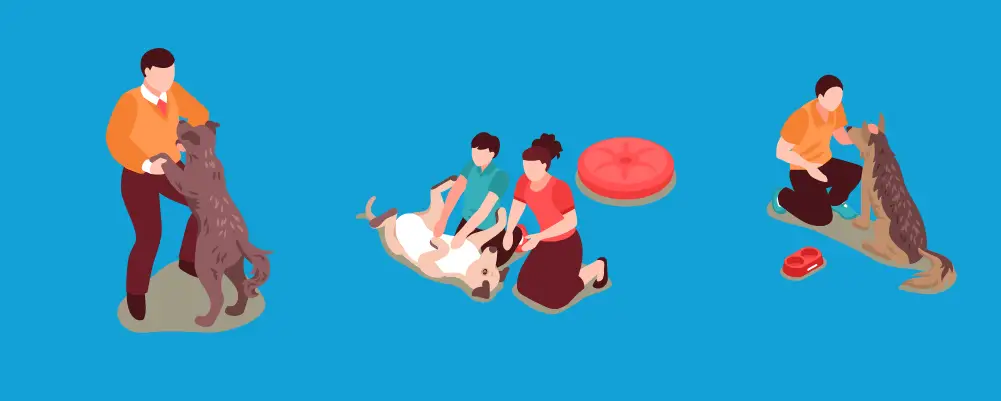
Adopting a new furry family member can be a hugely rewarding experience, but it’s not a decision that should be taken lightly.
As a dog who was adopted as a pup themselves, I know all that goes into the dog adoption process and how, at the end of it, you can change a dog’s life. In fact, almost 3.2 million lives of animals living in shelters are changed every year thanks to pet adoption,
It’s therefore important that you do the proper research before taking on such a large commitment and responsibility, which includes making sure you choose a breed that fits in with your lifestyle, puppy-proof your home, and stock up on supplies prior to their arrival.
I’ve put together the ultimate guide to adopting a dog to help prepare you for the adoption process, what it entails, and the subsequent adventure ahead, covering all you need to know about adopting the newest member of your family so that you can look forward to it.
You might be nervous now, but you’ll be so grateful that you’ve taken the time to research your decision – you can take my woof for it!
Preparing to Adopt a Dog
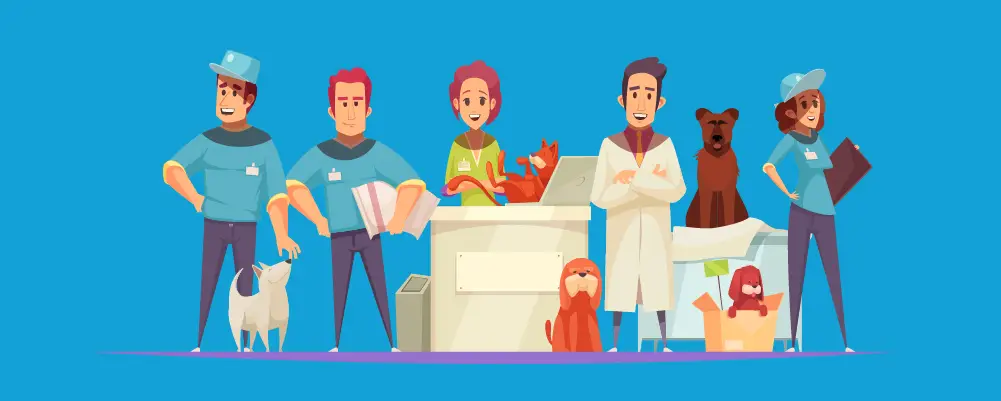
In order to make the transition to a new home easier for your new furry family member, it’s important to prepare a few things in advance of their eagerly awaited arrival. This includes a mixture of literally preparing your home and putting certain plans in place before they arrive.
Establishing House Rules
The initial first few days or even weeks after adopting your dog are crucial for establishing a new household routine so everyone can adjust to the addition of your new family member.
This includes deciding which rooms of the house your dog will be allowed in (I recommend all of them), where they will be sleeping (in your bed, of course), whether or not they can jump on the couch (do I even need to dignify this with an answer?) among other house rules.
Things are subject to change, of course, and nothing is set in stone. My humans tried to keep me off the couch for the first 6 weeks after I arrived, but I soon wore them down. However, having some clear boundaries in your head will help you create this new routine.
Dividing Petcare Responsibilities Between the Household
If you live alone, then I guess this step is pretty easy, and you’re one step closer to having some canine companionship in your home!
For anyone with multiple humans living in your household, it can be useful to divide the responsibilities involved with looking after a dog between you so you each know what your main duties are. Many paws make light work, as they say, or I guess hands in your case.
So, which lucky human gets to be in charge of potty training and trips out to the yard? Who will go out for walkies and exercise? Who will take on the majority of training duties? Finally, and this here is the most important job of all, who will make sure that dinner is on time?
This is also a great way to reinforce the whole “if you want to get a dog, you’ll have to take them on a walk every day” tactic that I’ve heard used on younger humans before, which will help teach them about responsibility from an early age.
Dog-Proofing
Adopting a dog means their safety is entirely your responsibility, so it’s vital that you do a dog-proofing sweep of your house before their arrival to ensure there are no hazards.
Exposed wires are a big one, as I’ve learned from painful experience that they’re not for nibbling on! You should also keep any medications or choking risks out of reach. If it helps, try to really get into the mindset of a dog and think about what they could most likely injure themselves on if left alone. Feel free to get down on all fours and pretend – I’m not judging.
As well as keeping your dog safe, you might want to think about protecting your home in case of any potential damage caused by your dog. It’s a known fact that when dogs are feeling anxious, which they may be after a big change like moving in with a new human family, they may act out with destructive behavior like chewing or scratching at the walls.
If you’re planning on not allowing your dog free roam of the upstairs areas in your home, it’s worth looking into having baby gates installed at the bottom and/or top of your stairs. This is an easy and safe way to keep your dog out of certain rooms.
Get Rid of Toxic Items
I’ll admit, I’m not the best at knowing what things are okay to eat and what is toxic for dogs. Seeing as dogs can’t read, it’s up to you to research and remove any toxic items at home.
This includes staple objects like cleaning products and any potted plants that could be poisonous to your pooch. That monstera plant you’ve been growing for months may look healthy, but your pup might not be if they decide to munch on a leaf or two before dinner.
There are plenty of natural alternatives available if you do discover that the cleaning products you use around your home are toxic to dogs, or you can even find recipes online to make your own cleaning solution out of bits you’ll likely already have in the cupboards.
Find a Vet in Your Area
I’ve noticed that humans have a tendency to put these things off, but finding a local vet before you adopt a dog and bring them home is something that shouldn’t be delayed. It’s hugely important, and you’ll want to have it sorted out prior to your dog’s arrival.
There’s nothing worse than being sick as a dog (pun intended) and not being able to receive medical attention because your human forgot to register you to a vet within the area. If you’re stuck on where to start looking, ask the shelter to see if they can recommend a vet.
Learn Basic Obedience Training Techniques
Your dog may have already learned some basic training commands during their time at the kennels or from their former family, but it’s important that you learn the basic obedience training techniques yourself so that you can continue their training when they come home.
This will help both you and your dog adjust to living together and will help to keep your dog out of harm’s way when there’s danger and you need them to listen to you.
The most important commands to successfully teach your dog include sit, stay, come, and leave. These will all be useful in helping your dog adjust to life in their new home as well as keeping them safe if you need them to listen to you for any reason.
Dog Supplies Needed
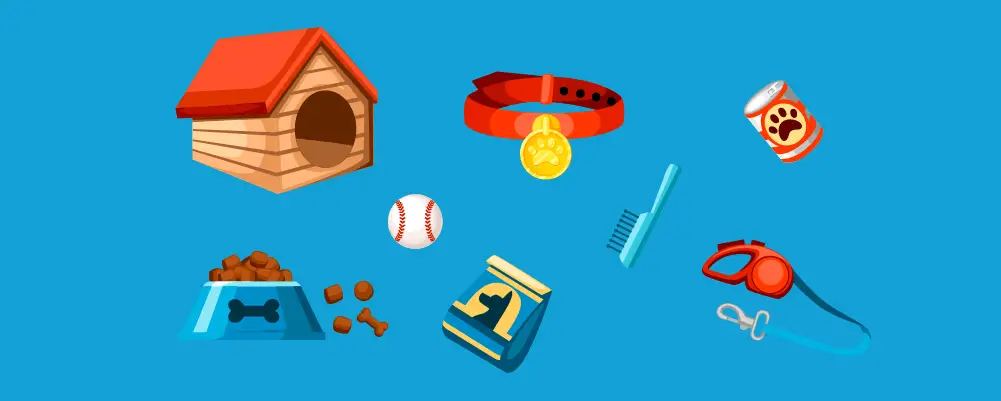
Pregnant people pack a hospital bag and spend weeks or sometimes months before the arrival of their baby stocking up on all the essential supplies.
Now, I’m not trying to say that my arrival was as momentous as the birth of the youngest human in my family, but if the collar fits…
So, let’s take a look at some of the dog supplies you should get before your pup’s arrival!
Crate or Kennel
Crate and kennel training aren’t for every dog, but they can be useful tools in transitioning your dog to home life.
There are a number of benefits to crate training, like providing a safe method of transportation in the case of an emergency. For example, if we needed to evacuate our home, my humans know I’ll happily go to my crate when I’m told thanks to crate training.
You do need to make sure you’ve done your research and picked the right size crate or kennel for your dog in order to make sure it’s comfortable for them. This is supposed to be a safe space for your dog to go to, so maybe place a blanket and a few favorite toys inside.
Dog-Specific Bedding
There are so many different bedding options for dogs these days, and yet most of the time, I still choose to sleep on my human’s bed. More specifically, on top of their heads/pillows.
It’s still important to pick up some dog-specific bedding when you’re shopping for supplies, however, as your dog might prefer having their own space designated for sleeping.
Food and Water Bowls
To help make sure my humans don’t mix up my food and theirs, they’ve given me my own special bowl for my food and water. It even has my name on it!
If your dog is a bit of a mucky pup while they’re eating, there are some great options like this one that features an overflow tray to catch any wayward chunks of food or sloshes of water.
Dog Food and Treats
The type of food and treats you should stock up on (and I mean really stock up) will depend on the breed of dog that you end up adopting. All dogs will have different dietary needs, requirements, and preferences, so make sure you have some before your dog comes home but be prepared to try a few different brands before you find the right one.
You could also find out what food is usually included in your dog’s diet from the shelter you adopt them from which can prevent an unsettled stomach while they try to settle in at home.
Collar and Leash
Walks are a key part of any dog’s life, so choosing the right collar and leash for them is essential so they can enjoy this time out of the house and exploring their new surroundings.
Some humans prefer to avoid collars and use harnesses instead, which can be a good option for larger dogs as it places less stress on their neck area if they pull on the lead. It also means they’re less likely to take you for a walk!
Grooming Supplies
Every dog loves strutting their stuff around the local park after a good old grooming session, so make sure to include some doggy grooming supplies on your shopping list.
Grooming is also a great way to bond with your dog which is so important right after you’ve adopted them in order to make them feel comfortable and happy in their new home.
Puppy Pads and Dog Waste Bags
It might take a while for your dog to get used to things in your home, so be patient with them while you train them to either only go outside or to use puppy pads. It’s a good idea to stock up on the latter just in case, even if you don’t plan on using them as part of your routine.
Dog-Friendly Cleaning Products
You may not realize it, but there’s a chance that some of your favorite cleaning products are actually toxic to dogs. We have a habit of licking things when we smell or sense something new, and certain products can make dogs sick if ingested.
This is why the dog-proofing preparation step is so important, so now you can replace anything that could potentially be toxic with cleaning products that are more dog friendly.
Dog Toys
Dog toys are about more than just playing, although this is hugely important for your dog to prevent boredom and the subsequent destruction of your home or belongings. Playing with toys can also be a great way for your and your dog to bond, and can help with loneliness.
That’s not to say you should be let loose in the dog toy aisle either, however. Instead, it’s recommended that you start off with a few to see which toys are your pooch’s favorite.
Kongs are a highly recommended toy for dogs, as they can be stuffed with treats of a tablespoon of peanut butter and frozen, providing the perfect chew toy for hot days.
There are also a number of good toy options to keep your dog engaged so they don’t become bored and destructive. If you’re planning on leaving your dog with a toy while you leave the house, however, always check that it’s okay to be left with them and that there are no potential choking hazards.
Finding Your Perfect Dog
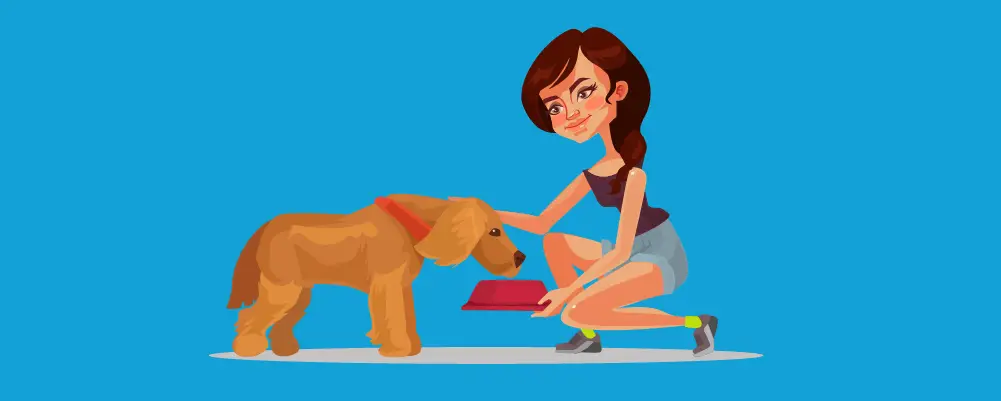
If you’re thinking about giving a dog a new home, you’ll need to seriously consider whether or not your home will be suitable. It’s all about finding the right dog for you and your lifestyle.
Does Breed Matter?
I would never support discriminating against any dog based on their breed, but you do need to think about your dog’s needs and requirements, and these do differ depending on the breed. For that reason, the breed actually does matter.
Golden retrievers, for example, will need to be walked for much longer than pugs, which you will need to take into account if you live a busy life where you’ll be short on spare time.
Puppy, Dog, or Senior?
Every dog is young at heart, and it’s definitely not true that you can’t teach a dog new tricks, but dogs have different needs throughout their stages of life which you’ll need to think about.
Puppies are much more high-maintenance and will take up a greater amount of your time than an older dog would, which is fine if you work from home or if you’ll be able to take on the huge responsibility of training your new puppy.
Senior dogs, however, make great companions for senior humans as they both enjoy a slower lifestyle with minimal to no walking requirements. There is, however, a higher risk of health complications to consider when you adopt an older dog.
What Size Dog?
Size matters too when you’re choosing a dog to adopt. A great dane won’t do well in a small one-bedroom apartment, and if you’re one of the smaller sized humans I’ve seen, you’ll have difficulty restraining your dog if they pull on the lead which can be dangerous for both of you.
Smaller dogs would not be able to handle long, strenuous walks, so if you’re looking for a companion to go with you on your next mountain hike, you’ll need to choose a larger breed.
Consider Your Lifestyle and Find a Dog That Fits
As I’ve said countless times already, the most important part about adopting a dog is finding the right lifestyle fit. Don’t find the perfect dog and try to dramatically change your lifestyle as you may find that it doesn’t work out which can lead to a heartbreaking goodbye.
Instead, take a long, hard look at what you can accommodate in your life, and only choose to adopt a dog if you know you can give them the full attention that they deserve.
Do Your Research
The only way to know what breed will suit your lifestyle best is to conduct thorough research.
To help you out, I’ll give you a quick rundown of some of the different dogs I’ve run into.
- Border Collies: They’re pretty smart, I’ll give them that. Border collies are also highly athletic – they can really chase for hours! If you’re limited on available time to take your dog out for a walk, avoid adopting a border collie.
- Schnauzers and Yorkshire Terriers: I’ve never known any dog to be as loud as these two breeds, so if you’ve got a terraced house a terrier might not be the right fit for you.
- Australian Shepherd Mix: I’m all for a good slobbery kiss, but dogs like this just looove to ‘herd’ with their mouth, which may not be ideal if there are young children in your home. If you love to nuzzle, however, they’d make a great companion!
- Poodles: Poodles can be kind of haughty, but I have to admit they have great fur. They’re a hypoallergenic breed as they don’t shed, which is perfect for the poor humans who are afflicted with a dog allergy.
- Labradors: You know, I’ve never met an unhappy labrador. This breed makes for great family dogs who are typically lovely around children, but they do need a fair bit of walking to keep them entertained.
These are just my personal opinions, however, and it’s important to remember that ultimately, every dog is unique.
It’s worth bearing in mind that a lot of dogs who come through shelters are mixed breeds, and in some cases, it can be difficult to determine what combination of breeds a dog is.
What to Expect at the Shelter?

The rules of each shelter are different, so you might want to search on that thing called the internet and see what the guidelines are for the shelter you’re visiting. This can help you know what to expect before you turn up and if there’s anything that you should be aware of.
Managing Expectations
I’ll start by telling you what not to expect first. Don’t think you’ll go in and meet your new furry family member straight away. It can be difficult to walk away on your two long legs once you’ve decided on adopting a dog, but as I keep saying, it’s important to find the right match.
This means knowing when to accept that your forever companion isn’t at the shelter, and being prepared to wait for the right fit to come along when the time is right. Click here to read more about the common mistakes people make in the first month after adopting a dog.
Bring a Notepad and Ask Questions
There can be quite a lot of that pesky paperwork that you humans seem so fond of when you’re adopting a dog, but it’s all worth it to take your new companion home with you.
It can be a good idea to use those opposable thumbs that God gave you to take notes, so bring a notepad and a pen with you when you visit so you can write down any important information that you’ll need to recall later. If the shelter allows you to take photos of the dogs, this can be a good way to jog your memory if you make notes about the dogs you like.
Spend Time With the Dogs
I’m a big believer in love at first sight – just ask my Neighbours dog, Sparkle. When it comes to adopting a dog, however, you should really try to spend as much time with them before you’re allowed to bring them home with you.
This will help you to form a deeper bond with your dog and they can get to know you better. You’ll also be able to gauge a better idea of their personality, their behavior, and their disposition, which will all be important factors in determining your compatibility.
If you’re allowed, ask to spend some time with the dogs outside of their kennels which will give you the opportunity to play with them and see which dogs you have a connection with.
You can’t judge a book by its cover, and you can’t judge a dog by how cute they are, as this could lead to a bad fit which often ends in dogs being returned to the shelter.
The Adoption Questionnaire – What to Expect?
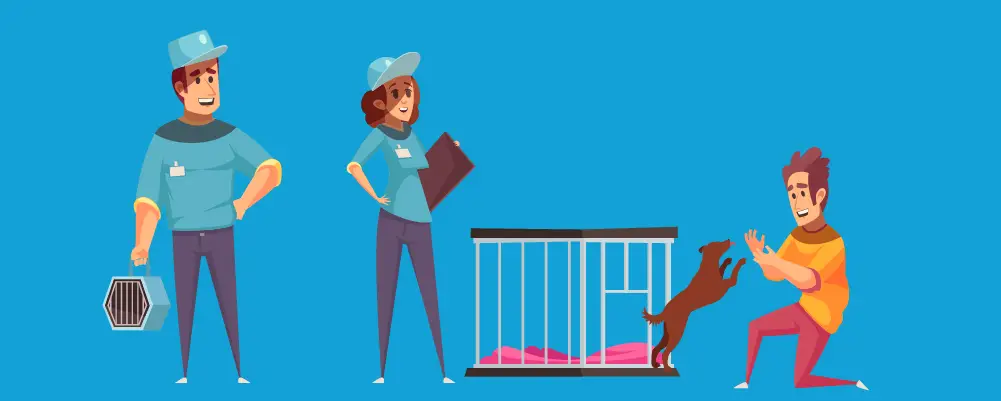
After you’ve met the dogs at the shelter and you’ve met your new forever companion, you’ll need to actually begin the formal adoption process. Back at the shelter, we liked to think of it as a sort of graduation for stray dogs. For us, it involves celebrating, for you, paperwork.
This includes the adoption questionnaire which all humans are expected to fill out before they are allowed to adopt a dog. In case you’re not sure what to expect, here are some of the common types of questions you’ll likely be asked at the shelter.
- Why are you choosing to adopt a dog?
- How many people are there living in your household?
- How many hours in the day do you spend away from home?
- Where will your dog be sleeping at night?
- Do you own your home or live in rented accommodation?
- Do you have any other pets? What are they? Are they spayed or neutered? Have they had all of their vaccinations?
- Have you ever had to leave a dog at a shelter and if so, why?
- Have you had previous pets?
- Are you planning on taking them to dog training and obedience classes?
As well as filling out the questionnaire, one of the kind humans who work at the shelter will sit with you and ask you a few more questions based on the answers you’ve already given.
It can sometimes feel like you’re being interviewed when you’re asked these types of questions at the shelter, but I can assure you that their only purpose is to ensure that you’re capable of handling the requirements of the dog you would like to adopt.
Questions to Ask at the Shelter

The humans who work at the shelter aren’t the only ones who get to ask questions. It’s important to make sure that you don’t get carried away in the excitement and forget to ask any important questions of your own, as this is your chance to seek some expert advice.
Here are some of the questions I overheard my humans ask when they were in the process of adopting me, to provide you with some inspiration if you’re stuck on where to start.
- How long has the dog been living at the shelter, and how did they come to be there?
- What do you know about the dog’s history before they came to the shelter?
- Do they have any health issues or conditions that you are aware of?
- Has the dog ever been abused in a previous home?
- What food would you recommend for them?
- Do you have any recommendations for local vets or obedience trainers?
- Have the staff noticed any behavioral quirks or tendencies worth pointing out?
- Do they understand the basic commands such as ‘sit’ and ‘come’?
- How does the dog behave around children or other animals?
- How does the dog behave on the lead and on dog walks?
Yeah, my humans were pretty thorough. A lot of this will have probably been discussed or brought up at an earlier point anyway, but if they haven’t, now is your time to speak up!
Next Steps

If you’re approved based on your adoption questionnaire and responses, you’ll then be asked to pay a donation or adoption fee, and you’ll sign an agreement as proof that you’ve adopted your new furry forever friend. You can pretty much take your dog home, then!
The only exception to this is if they need to be spayed or neutered first, but after that, they’ll be good to go.
One last thing to point out is that adopting a dog is a huge commitment and will be a serious responsibility. You might feel bad if you’re starting to feel like you’ve made the wrong decision and that adopting this dog, or any dog, isn’t a good idea, but you’ll feel worse if you carry on with the process anyway and end up regretting it, then bringing the dog back.
Summary
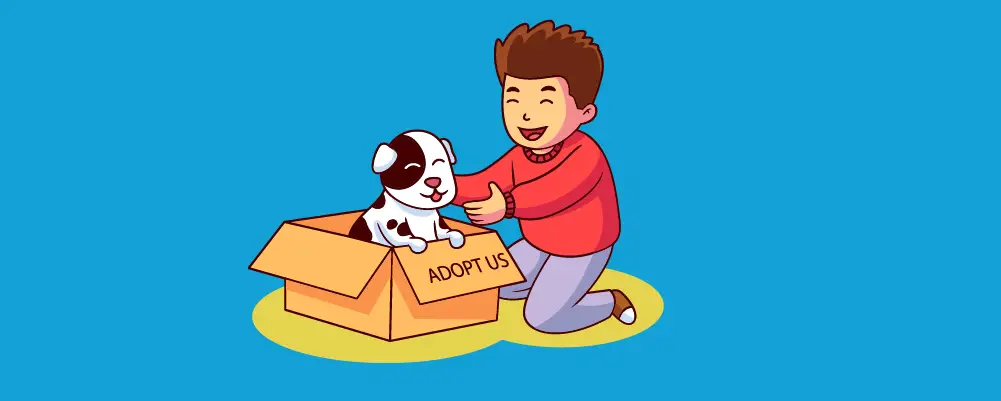
For a change, it’s me who has taken you for a walk – through the adoption process including how to prepare, what to prepare, and what happens when the time for preparation is over.
Just remember the most important thing, which is to shower your new dog with love and affection, whilst at the same time giving them enough space to settle in without overcrowding them. Remain patient and I’m sure that in no time, you won’t remember what life was even like before the wonderful addition of your newly adopted furry family member.
I’d love to stick around and woof with you a while longer, but it’s time to get back to my own forever family! I hope that expanding yours brings you as much joy as it has for us!